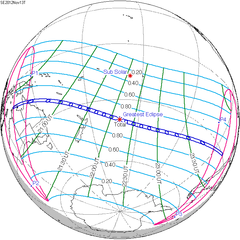|
November 2021 lunar eclipse
A partial lunar eclipse occurred at the Moon’s ascending node of orbit on Friday, November 19, 2021,[2] with an umbral magnitude of 0.9760. A lunar eclipse occurs when the Moon moves into the Earth's shadow, causing the Moon to be darkened. A partial lunar eclipse occurs when one part of the Moon is in the Earth's umbra, while the other part is in the Earth's penumbra. Unlike a solar eclipse, which can only be viewed from a relatively small area of the world, a lunar eclipse may be viewed from anywhere on the night side of Earth. Occurring only about 12 hours before apogee (on November 20, 2021, at 21:10 UTC), the Moon's apparent diameter was smaller.[3] This was the longest partial lunar eclipse since February 18, 1440, and the longest until February 8, 2669; however, many eclipses, including the November 2022 lunar eclipse, have a longer period of umbral contact at next to 3 hours 40 minutes.[4][5] It was often referred to as a "Beaver Blood Moon" although not technically fulfilling the criteria for a true blood moon (totality). This lunar eclipse was the second of an almost tetrad, with the others being on May 26, 2021 (total); May 16, 2022 (total); and November 8, 2022 (total). VisibilityThe eclipse was completely visible over northeast Asia, the Pacific Ocean, and North America, seen rising over east Asia and Australia and setting over South America.[6]
Gallery
Eclipse detailsShown below is a table displaying details about this particular solar eclipse. It describes various parameters pertaining to this eclipse.[7]
Eclipse seasonThis eclipse is part of an eclipse season, a period, roughly every six months, when eclipses occur. Only two (or occasionally three) eclipse seasons occur each year, and each season lasts about 35 days and repeats just short of six months (173 days) later; thus two full eclipse seasons always occur each year. Either two or three eclipses happen each eclipse season. In the sequence below, each eclipse is separated by a fortnight.
Related eclipsesEclipses in 2021
Metonic
Tzolkinex
Half-Saros
Tritos
Lunar Saros 126
Inex
Triad
Lunar eclipses of 2020–2023This eclipse is a member of a semester series. An eclipse in a semester series of lunar eclipses repeats approximately every 177 days and 4 hours (a semester) at alternating nodes of the Moon's orbit.[8] The penumbral lunar eclipses on January 10, 2020 and July 5, 2020 occur in the previous lunar year eclipse set.
Tritos seriesThe tritos series repeats 31 days short of 11 years at alternating nodes. Sequential events have incremental Saros cycle indices. This series produces 20 total eclipses between April 24, 1967 and August 11, 2185, only being partial on November 19, 2021.
Saros 126This eclipse is a part of Saros series 126, repeating every 18 years, 11 days, and containing 70 events. The series started with a penumbral lunar eclipse on July 18, 1228. It contains partial eclipses from March 24, 1625 through June 9, 1751; total eclipses from June 19, 1769 through November 9, 2003; and a second set of partial eclipses from November 19, 2021 through June 5, 2346. The series ends at member 70 as a penumbral eclipse on August 19, 2472. The longest duration of totality was produced by member 36 at 106 minutes, 27 seconds on August 13, 1859. All eclipses in this series occur at the Moon’s ascending node of orbit.[9]
Eclipses are tabulated in three columns; every third eclipse in the same column is one exeligmos apart, so they all cast shadows over approximately the same parts of the Earth.
Metonic series
Half-Saros cycleA lunar eclipse will be preceded and followed by solar eclipses by 9 years and 5.5 days (a half saros).[11] This lunar eclipse is related to two total solar eclipses of Solar Saros 133.
See alsoReferences
External linksWikimedia Commons has media related to Lunar eclipse of 2021 November 19.
|
|||||||||||||||||||||||||||||||||||||||||||||||||||||||||||||||||||||||||||||||||||||||||||||||||||||||||||||||||||||||||||||||||||||||||||||||||||||||||||||||||||||||||||||||||||||||||||||||||||||||||||||||||||||||||||||||||||||||||||||||||||||||||||||||||||||||||||||||||||||||||||||||||||||||||||||||||||||||||||||||||||||||||||||||||||||||||||||||||||||||||||||||||

































































































